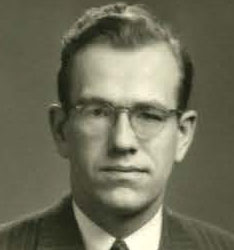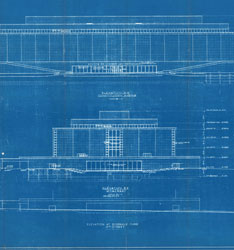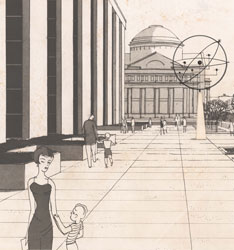
“Those narrow slats almost recall the colonnade down in the Lincoln [memorial] or the one across the street or the one here on the Natural History [museum].”
—Walker O. Cain, MHT architect, 1988
Designing a Modern Museum
MHT’s architects envisioned a modern building for a modern museum. It would be the concrete embodiment of its ideals. Yet MHT also had to harmonize with nearby neoclassical structures.
Chief architect James Kellum Smith compared MHT to the Acropolis and ancient Rome. When he died in 1961, Walker O. Cain took over and affirmed Smith’s direction, agreeing that the Mall “is a classical environment if there ever was one.”
Cain said he designed “a building which is classical in definition, and the detailing is modern.” The alternating pattern of the building’s walls, for example, was meant to suggest Greek columns. Avant-garde touches included Jose de Rivera’s “Infinity,” one of the first abstract sculptures at a major public building in Washington. To Cain, “Infinity” evoked an orrery—a mechanical model of the solar system. His interest in science and technology is also reflected in one of the icons of the Museum—the Foucault pendulum was Cain’s idea.
Reproduction of rendering of MHT by Hugh Ferriss, architect and the era’s foremost delineator of buildings.
Blueprint of Museum of History and Technology, McKim, Mead, and White, architects, elevations of 12th Street and Constitution Avenue sides.




